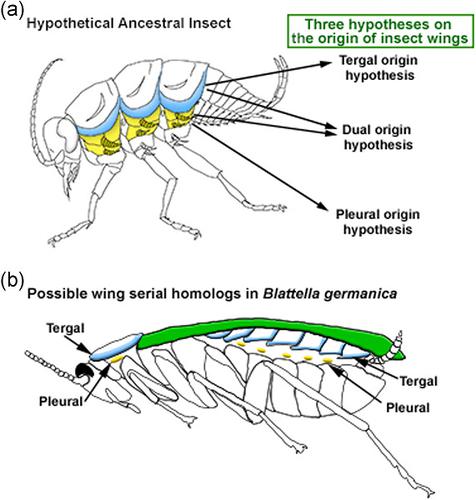当前位置:
X-MOL 学术
›
Evol. Dev.
›
论文详情
Our official English website, www.x-mol.net, welcomes your
feedback! (Note: you will need to create a separate account there.)
Tergal and pleural wing‐related tissues in the German cockroach and their implication to the evolutionary origin of insect wings
Evolution and Development ( IF 2.6 ) Pub Date : 2021-01-27 , DOI: 10.1111/ede.12372 Courtney Clark-Hachtel 1 , Ana Fernandez-Nicolas 2 , Xavier Belles 2 , Yoshinori Tomoyasu 1
Evolution and Development ( IF 2.6 ) Pub Date : 2021-01-27 , DOI: 10.1111/ede.12372 Courtney Clark-Hachtel 1 , Ana Fernandez-Nicolas 2 , Xavier Belles 2 , Yoshinori Tomoyasu 1
Affiliation

|
The acquisition of wings has facilitated the massive evolutionary success of pterygotes (winged insects), which now make up nearly three‐quarters of described metazoans. However, our understanding of how this crucial structure has evolved remains quite elusive. Historically, two ideas have dominated in the wing origin debate, one placing the origin in the dorsal body wall (tergum) and the other in the lateral pleural plates and the branching structures associated with these plates. Through studying wing‐related tissues in the wingless segments (such as wing serial homologs) of the beetle, Tribolium castaneum, we obtained several crucial pieces of evidence that support a third idea, the dual origin hypothesis, which proposes that wings evolved from a combination of tergal and pleural tissues. Here, we extended our analysis outside of the beetle lineage and sought to identify wing‐related tissues from the wingless segments of the cockroach, Blattella germanica. Through detailed functional and expression analyses for a critical wing gene, vestigial (vg), along with re‐evaluating the homeotic transformation of a wingless segment induced by an improved RNA interference protocol, we demonstrate that B. germanica possesses two distinct tissues in their wingless segments, one with tergal and one with pleural nature, that might be evolutionarily related to wings. This outcome appears to parallel the reports from other insects, which may further support a dual origin of insect wings. However, we also identified a vg‐independent tissue that contributes to wing formation upon homeotic transformation, as well as vg‐dependent tissues that do not appear to participate in wing formation, in B. germanica, indicating a more complex evolutionary history of the tissues that contributed to the emergence of insect wings.
中文翻译:

德国大蠊的 Tergal 和胸膜翅相关组织及其对昆虫翅膀进化起源的影响
翅膀的获得促进了有翼昆虫(有翅膀的昆虫)在进化上的巨大成功,现在这些昆虫占所描述的后生动物的近四分之三。然而,我们对这一关键结构如何演变的理解仍然非常难以捉摸。从历史上看,有两种观点在翼起源争论中占主导地位,一种将起源置于背体壁(tergum),另一种置于侧胸膜板和与这些板相关的分支结构。通过研究甲虫无翅节段(如翅系列同源物)中的翅膀相关组织,赤刺栗,我们获得了支持第三个想法的几个关键证据,即双重起源假说,该假说提出翅膀是从三叶组织和胸膜组织的组合进化而来的。在这里,我们将我们的分析扩展到甲虫谱系之外,并试图从蟑螂德国小蠊的无翅节段中识别出与翅膀相关的组织。通过对关键翼基因vestigial ( vg ) 的详细功能和表达分析,以及重新评估由改进的RNA 干扰方案诱导的无翼片段的同源异体转化,我们证明了德国双歧杆菌在它们的无翅节段中具有两种不同的组织,一种具有胸膜性质,一种具有胸膜性质,这可能在进化上与翅膀有关。这一结果似乎与其他昆虫的报告相似,这可能进一步支持昆虫翅膀的双重起源。然而,我们还在德国芽孢杆菌中发现了一种不依赖vg的组织,该组织有助于同源异形转化时的翅膀形成,以及似乎不参与翅膀形成的 vg 依赖性组织,这表明该组织的进化历史更为复杂这促成了昆虫翅膀的出现。
更新日期:2021-03-01
中文翻译:

德国大蠊的 Tergal 和胸膜翅相关组织及其对昆虫翅膀进化起源的影响
翅膀的获得促进了有翼昆虫(有翅膀的昆虫)在进化上的巨大成功,现在这些昆虫占所描述的后生动物的近四分之三。然而,我们对这一关键结构如何演变的理解仍然非常难以捉摸。从历史上看,有两种观点在翼起源争论中占主导地位,一种将起源置于背体壁(tergum),另一种置于侧胸膜板和与这些板相关的分支结构。通过研究甲虫无翅节段(如翅系列同源物)中的翅膀相关组织,赤刺栗,我们获得了支持第三个想法的几个关键证据,即双重起源假说,该假说提出翅膀是从三叶组织和胸膜组织的组合进化而来的。在这里,我们将我们的分析扩展到甲虫谱系之外,并试图从蟑螂德国小蠊的无翅节段中识别出与翅膀相关的组织。通过对关键翼基因vestigial ( vg ) 的详细功能和表达分析,以及重新评估由改进的RNA 干扰方案诱导的无翼片段的同源异体转化,我们证明了德国双歧杆菌在它们的无翅节段中具有两种不同的组织,一种具有胸膜性质,一种具有胸膜性质,这可能在进化上与翅膀有关。这一结果似乎与其他昆虫的报告相似,这可能进一步支持昆虫翅膀的双重起源。然而,我们还在德国芽孢杆菌中发现了一种不依赖vg的组织,该组织有助于同源异形转化时的翅膀形成,以及似乎不参与翅膀形成的 vg 依赖性组织,这表明该组织的进化历史更为复杂这促成了昆虫翅膀的出现。











































 京公网安备 11010802027423号
京公网安备 11010802027423号